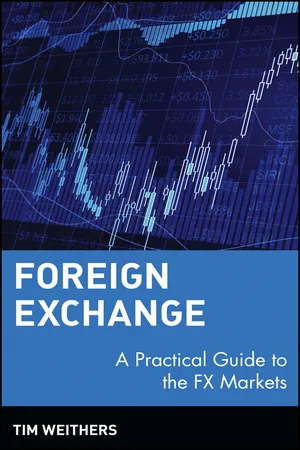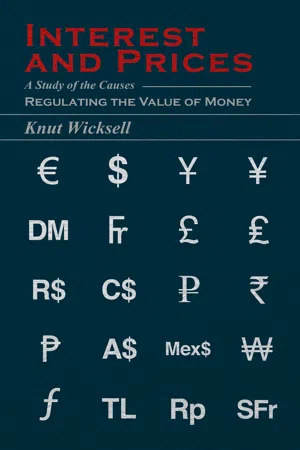Behavior of Interest Rates
The behavior of interest rates refers to the movement and fluctuations of interest rates over time. It encompasses factors such as supply and demand for credit, inflation expectations, central bank policies, and overall economic conditions. Understanding the behavior of interest rates is crucial for businesses, investors, and policymakers in making financial decisions and managing risk.
4 Key excerpts on "Behavior of Interest Rates"
- eBook - ePub
Money and Banking
An International Text
- Robert Eyler(Author)
- 2009(Publication Date)
- Routledge(Publisher)
...This relationship between the quantity of cash or liquidity demanded and the interest rate is of key importance to a great deal of macroeconomic theories but also to monetary and fiscal policy in practice. The way consumers react to changes in interest rates paid on their cash holdings changes the demand for goods and services, as well as the demand for lending. However, for now the idea is simple: the interest rate is the opportunity cost of holding money in your wallet rather than in an interest-bearing account or investment. Measure of time preference It is this definition that links the three above and binds them in the household’s eyes. When you chose to consume more than your income, or consume with credit rather than paying in full, you are making a choice about your time preference to consume. The interest rate is a measure of how people prefer to consume with respect to time: if the interest rate falls, there will be marginal changes in consumption based on a smaller cost of credit. Certain households which initially would save, say $1000, now spend $100 of that $1000 and save only $900. They still save a certain amount, but it is less. The lower interest rate has triggered an incentive for them to spend on credit, or prefer to spend now than later in time. The cost of borrowing falls in the previous example, providing an incentive to borrow. Certain lenders must provide the loan, thus they see the interest rate as the revenue from lending, and want to take advantage of it. Finally, the borrower must demand cash in order to spend, thus the cost of holding money must also be going down at the same time, and intuitively it does. The interest rate is all four of these ideas simultaneously, and must be for financial markets to work correctly...
- eBook - ePub
- (Author)
- 2011(Publication Date)
- Wiley(Publisher)
...Even short-term interest rates respond to these expectations. Most economists do agree that, for whatever reasons, as the inflation rate rises, so do interest rates. A clear indication of the direction of inflation is one of the most important factors in forecasting the level of interest rates. The Nation's Flow of Funds Interest rates are essentially the prices of different kinds of credit. These prices tend to equalize the supply and demand for credit throughout the economy. If there is a high demand for credit, interest rates will rise. This simultaneously makes it more expensive to borrow (thereby reducing credit demand) and attracts prospective lenders (increasing credit supply). If demand for credit falls, interest rates will fall. This makes it less expensive to borrow, so credit demand increases, and the supply of credit decreases because the lower rate is less attractive to prospective lenders. Changes in the supply of credit affect interest rates in the opposite way. If there are more funds available to buy fixed income securities, rates will be pushed down. If there are fewer funds available to buy these securities, rates will be pushed up. Many economists at brokerage firms and banks closely analyze the nation's capital flows to forecast interest rates. The object is to project the major demands for borrowing, on the one hand, and to project the major sources of the supply of lending, on the other. The projections, of course, are closely related to forecasts of the business cycle in general. The Federal Reserve publishes an invaluable series of accounts to facilitate such an analysis. It is called the Flow of Funds Accounts of the United States and traces just how money flows through the entire economy. Economists use this tool to forecast the various components of the supply and demand for credit. Unusually heavy needs on the part of municipalities or the federal government, for example, can be assessed in this light...
- eBook - ePub
Foreign Exchange
A Practical Guide to the FX Markets
- Tim Weithers(Author)
- 2011(Publication Date)
- Wiley(Publisher)
...These are the rates we have been talking about thus far. The price of one-year money does not have to be the same as the price of two-year money. This phenomenon is known as the “term structure of interest rates”; it is often depicted graphically as in Figure 3.1. The usual shape for the term structure of interest rates is as shown. There are a few explanations for this shape, which often go by the name of different theories. One suggests that you require a premium (a higher interest rate) for tying up your money for a longer time frame (e.g., entering into a longer-term deposit). This recognizes that people prefer to have their money available (or liquid) and so is known as the “liquidity preference hypothesis.” Another explanation focuses on the connection between interest rates and inflation. If inflation is particularly low (relative to historical levels)—as it has been in recent times in the United States—then the market’s belief may be that inflation will likely return to a more typical higher level in the future, and so longer-term interest rates will reflect the higher expected rates of inflation (as mentioned previously through the Fisher relationship). This is called the “expectations theory.” Finally, there is an explanation known as “segmented markets”; this simply acknowledges that the interest rate for any given point in the future (the price of money over time) is driven by demand and supply (that is, by borrowing and lending). The demand and supply for short-term financing can differ from the demand and supply for longer-term financing, so short-term interest rates can differ from long-term interest rates. Although none of these rationales fully explains the term structure of interest rates, they all highlight an aspect of the shape of this “curve,” which can be observed every day in the media...
- Knut Wicksell(Author)
- 2011(Publication Date)
- Josephs Press(Publisher)
...For neither an individual bank nor the banks of an individual country can on their own initiative embark on any change without keeping in accord with the procedure adopted by other banks. The open market may perhaps seem to present a somewhat more lively picture, but it is practically certain that the lending rate of interest never follows directly on movements of the natural rate, and usually follows them only very slowly and with considerable hesitation. During the period of transition, the deviation between the two rates has full play, resulting in that phenomenon, often referred to above, which on a superficial view appears to contradict our theory but in reality is in complete accordance with it: prices rise when the rate of interest (the capital rate and consequently the money rate) is high and rising, and in the contrary case they fall. This brings us to a consideration which has for a long time been emphasised by various writers. When the rate of interest (both the capital and the money rate) is high, there is an obvious tendency for money to circulate somewhat more rapidly, for “hoards” of coin and bullion to be drawn out of their hiding-places, and for the employment of all credit instruments to become more profitable—in short, there is a tendency for prices to rise (though only once and for all, not progressively). A low rate of interest has in all respects the opposite tendency: certain kinds of credit instrument can no longer be used at all, because such payments as the stamp duty on bills and the tax on notes would absorb too substantial a part of the interest: other things being equal, prices stand at a lower level. In its essence this is merely a special case of our general proposition. For it is only so long as these various factors maintain the money rate of interest either above or below the appropriate level of the natural rate that prices will continue moving in the one direction or the other...



